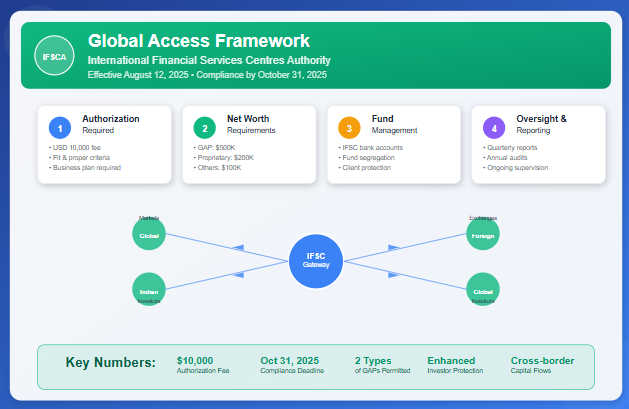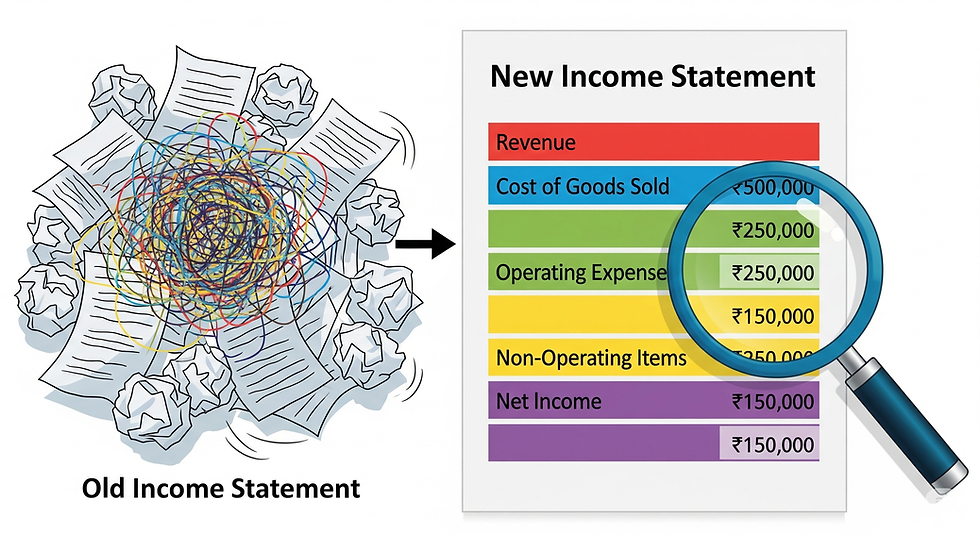IFSCA Unveils Comprehensive Global Access Framework for IFSC: A Gateway to International Financial Markets
- GDV Consultancy
- Aug 13
- 3 min read
The IFSCA has revolutionized cross-border capital flows by introducing a comprehensive regulatory framework for Global Access Providers (GAPs) operating within India's International Financial Services Centres. This landmark circular, effective August 12, 2025, positions the IFSC as a strategic gateway connecting Indian and global financial markets while ensuring investor protection and regulatory compliance.

Key Regulatory Changes
New Authorization Requirements
The framework introduces mandatory authorization for all Global Access Providers, with existing operators required to comply by October 31, 2025. This represents a significant shift from the previous voluntary registration system to a more structured regulatory approach.
Enhanced Capital Requirements
The new framework establishes tiered minimum net worth requirements:
Full-service GAPs: USD 500,000
Proprietary-only GAPs: USD 200,000
Other Broker Dealers: USD 100,000
These requirements must be maintained separately from other business activities, ensuring dedicated capital allocation for global access operations.
Eligible Participants and Client Categories
Global Access Providers
The framework recognizes two primary categories of GAPs:
Subsidiaries of Recognised Stock Exchanges established in the IFSC
Broker Dealers with direct arrangements with foreign brokers for client or proprietary trading
Permitted Client Base
Global access services are available to:
Indian Residents: Subject to Foreign Exchange Management Act (FEMA) provisions and Liberalised Remittance Scheme limits
Non-Indian Residents: As permitted under FEMA regulations
Product Scope and Restrictions
Permitted Products
GAPs can provide access to all financial products listed on foreign stock exchanges, provided they fall within the IFSC's definition of "financial products."
Notable Exclusions
The framework explicitly prohibits access to:
Crypto-assets and crypto-backed instruments
Index derivatives available on IFSC exchanges
Single stock derivatives traded in the IFSC
Bond derivatives offered domestically
USD-INR/INR-USD derivatives available in the IFSC
Operational Infrastructure and Compliance
Fund Management Requirements
The new framework mandates strict fund segregation:
All client funds must be routed through IFSC bank accounts
Separate accounts for global access and IFSC activities
Client funds must be segregated from proprietary trading funds
All banking relationships must be with International Banking Units in the IFSC
Data Governance
GAPs must maintain all user, transaction, and trade data within the IFSC, ensuring regulatory accessibility and compliance with data localization requirements.
Risk Management Framework
The circular emphasizes robust risk management systems, particularly for client-facing operations, with comprehensive internal controls to protect investor interests.
Enhanced Disclosure and Transparency
Mandatory Client Disclosures
GAPs must provide comprehensive written disclosures covering:
Risk factors associated with global market investments
Detailed fee structures and charges
Custody arrangements and account structures
Tax implications and regulatory requirements
Investor protection limitations
Website Requirements
All GAPs must maintain dedicated webpages providing detailed information about global access arrangements, ensuring transparency for prospective clients.
Regulatory Oversight and Reporting
Compliance Framework
The framework establishes multiple oversight layers:
Quarterly reporting to IFSCA
Annual independent audits by qualified professionals
Ongoing supervision by recognized stock exchanges (limited to trading activities)
Authority-appointed inspections when necessary
Fee Structure
The new framework introduces a comprehensive fee structure:
Authorization Fee: USD 10,000
Recurring Fees: Based on turnover with different rates for derivatives (0.000075%) and other products (0.005%)
Fees apply to both proprietary and clientele trading activities
Strategic Implications
Market Development
This framework positions the IFSC as a sophisticated financial hub capable of facilitating seamless global market access while maintaining regulatory integrity. The structured approach is expected to attract institutional investors and enhance India's role in international capital flows.
Investor Protection
The comprehensive disclosure requirements, fund segregation mandates, and enhanced oversight mechanisms demonstrate IFSCA's commitment to investor protection while fostering market development.
Compliance Timeline
Existing operators have a clear compliance timeline with the October 31, 2025 deadline for authorization, website updates, fund routing compliance, and risk disclosure implementation.
Industry Impact and Future Outlook
The new framework reflects IFSCA's evolution from a developing regulatory authority to a mature financial services regulator. By establishing clear operational guidelines while maintaining flexibility for innovation, the framework balances regulatory oversight with market development objectives.
The emphasis on technology infrastructure, data governance, and cross-border compliance positions the IFSC to compete effectively with established international financial centers while maintaining India's regulatory standards.
Conclusion
IFSCA's comprehensive global access framework represents a significant milestone in India's financial services evolution. By establishing clear regulatory parameters while facilitating international market access, the framework creates a robust foundation for the IFSC's growth as a global financial gateway.
The October 31, 2025 compliance deadline provides existing market participants sufficient time to align their operations with the new requirements, while the structured approach ensures sustainable market development with appropriate investor protections.
This regulatory advancement positions India's IFSC as an increasingly attractive destination for international financial services, potentially accelerating cross-border capital flows and enhancing India's integration with global financial markets.




Comments